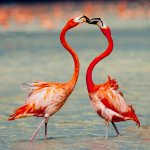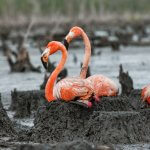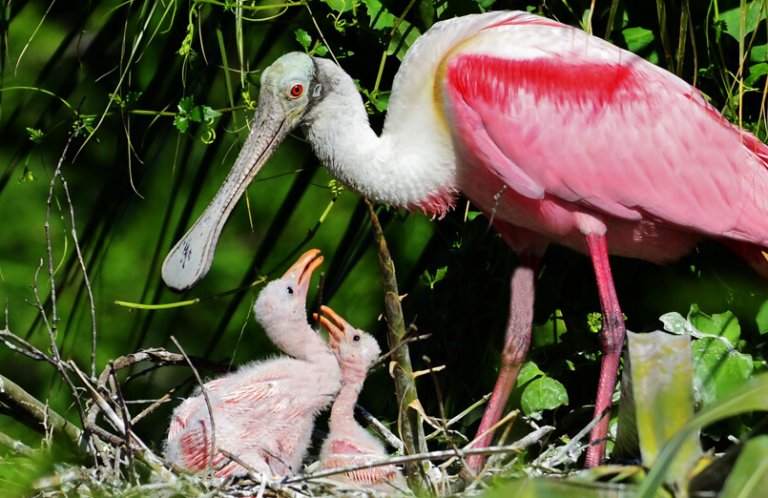About the American Flamingo
The salmon-pink American Flamingo is one of the best-known and most beloved birds. The most colorful of the world's six flamingo species, it is popular in zoos, and people see its likeness on everything from toys to casinos to lawn ornaments. Yet wild flamingos are a rare sight in the U.S., where people are usually more likely to mistake distant Roseate Spoonbills for the "real thing." In addition to being pink, the American Flamingo stands out from other wading birds like the Great Blue Heron and Wood Stork by its much longer neck and legs, and its bent-looking bill. It turns out that in 2023, many people got to see these differences for themselves.
During this banner year, American Flamingos were reported in no less than 14 states, many of which had no prior records for the species. At least 150 individuals turned up, even in such unlikely places as Kansas, Pennsylvania, and Wisconsin.
Pink Sprinkles the Landscape
From a flock on Lake Michigan in Wisconsin down to many Florida locations, the scope and numbers of the 2023 flamingo "invasion" are certainly unprecedented in recent decades. Until plume hunters wiped them out by the early 1900s (a fate which almost befell other showy species such as the Great Egret), flamingos were present year-round in South Florida. But in years since, these striking birds have only remained on U.S. birders' radar because individuals or small flocks continued to pop up, most regularly in South Florida. Many were considered escapes from zoos or collections, but others showed up after tropical disturbances.
The 2023 phenomenon certainly seems tied to Hurricane Idalia, which blew into Florida on August 30, sparking the wave of flamingo sightings. Several of the wayward birds had tags confirming their origin — from a Mexican breeding population on the Yucatán Peninsula.
Before Hurricane Idalia arrived, the only suspected wild flamingo known to be in the U.S. was a lone adult bird nicknamed Pinky. This bird apparently arrived via Hurricane Michael in 2018 and has remained at St. Marks National Wildlife Refuge, south of Tallahassee, Florida, ever since. The 2023 influx brought up to six new flamingos to the refuge; by early October, just two were seen, foraging together, one of which was believed to be Pinky.
Songs and Sounds
American Flamingos have a few different vocalizations. Flying flocks make honking calls somewhat reminiscent of Snow Geese. Feeding birds make muttering sounds. During courtship, males and females vocalize together, with females vocalizing at a higher pitch than males.
Listen here to a flock's honking calls:
Breeding and Feeding
Straining the Shallows
Most American Flamingos breed in large colonies on mudflats and saltpans. Nesting is often dependent upon adequate water levels on the flats where the birds nest. The female lays a single egg, rarely two, in an indentation atop a conical mud mound. Both parents take turns incubating the egg for about a month. After hatching, a young flamingo joins a group, or creche, of other juveniles, which is attended by a few adults. In the group, young flamingos learn how to forage, but it can take up to three months before they strike out on their own. Galápagos birds breed in small colonies and nest on small stone piles.

Flamingos' unusual boomerang-shaped bills enable these birds to efficiently strain the shallows for a variety of marine invertebrates, including crustaceans, mollusks, marine worms, and insects. They also eat algae and some plant matter. While foraging, the birds lower their heads, often immersing them completely under water, then swing their bills side to side, gathering muddy water that is filtered through the birds' grill-like lamellae (similar to those seen on the bills of ducks such as shovelers), aided by the tongue which is fringed with bristles. This straining expels water and silt, but traps prey in the birds' bills.
Region and Range
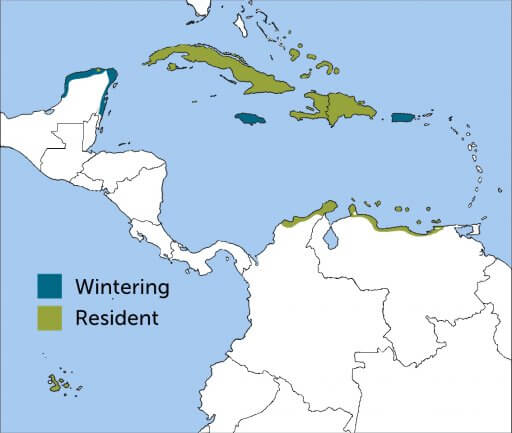
American Flamingos nest in colonies scattered from the Bahamas south to northern Venezuela, and also in the Galápagos Islands, where there is an isolated, genetically distinct population of 400 to 500 birds.
Outside nesting season, American Flamingos are regional migrants, moving to take advantage of the best food sources. For example, these birds winter on shallows all around the Yucatán Peninsula but breed in only a few spots there. These wanderings often bring members of different breeding colonies into contact.
Conservation
"The Flamingo is resident in the United States only in the vicinity of Cape Sable, Florida, where in 1890 Mr. W.E.D. Scott observed a flock of about a thousand birds," wrote ornithologist Frank M. Chapman in Birds of Eastern North America in 1896. This is among many reports confirming that flamingos were at least present, if not nesting, in Florida before plume hunters finished them off. Since then, flamingos have only occurred in the country as strays or escapes. Over the ensuing years, Florida Bay in Everglades National Park has been the most consistent location where these birds have popped up. Fittingly, in 2023, up to 75 storm-blown birds were tallied there. Conservationists are hopeful that some might stay and perhaps nest.
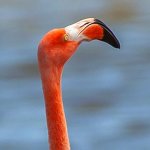
Help support ABC's conservation mission!
It's probably safe to say that most people have at least some fondness for flamingos. In recent decades, this popularity has fueled successful conservation efforts that have helped the American Flamingo population more than double since the 1990s, including renewed nesting in Venezuela, the Virgin Islands, and the eastern tip of Puerto Rico. Thriving colonies also occur in the Bahamas, Cuba, and Mexico, and on islands including Bonaire and Curaçao in the southern Caribbean.
Although their numbers are climbing, American Flamingos still face threats. They are highly sensitive to disturbance at their colonies, as well as habitat loss and degradation. In their coastal habitats, they also face dangers from pollution such as oil spills and collisions with poorly sited powerlines.
Get Involved
Policies enacted by the U.S. Congress and federal agencies, such as the U.S. Fish and Wildlife Service, have a huge impact on migratory birds. You can help shape these rules for the better by telling lawmakers to prioritize birds, bird habitat, and bird-friendly measures. To get started, visit ABC's Action Center.
Living a bird-friendly life can have an immediate impact on migratory birds in the United States. Doing so can be as easy as adding native plants to your garden, avoiding pesticides, and keeping cats indoors. To learn more, visit our Bird-Friendly Life page.
American Bird Conservancy and our Migratory Bird Joint Venture partners have improved conservation management on more than 8.5 million acres of U.S. bird habitat — an area larger than the state of Maryland — over the last ten years. That's not all: With the help of international partners, we've established a network of more than 100 areas of priority bird habitat across the Americas, helping to ensure that birds' needs are met during all stages of their lifecycles. These are monumental undertakings, requiring the support of many, and you can help by making a gift today.






































